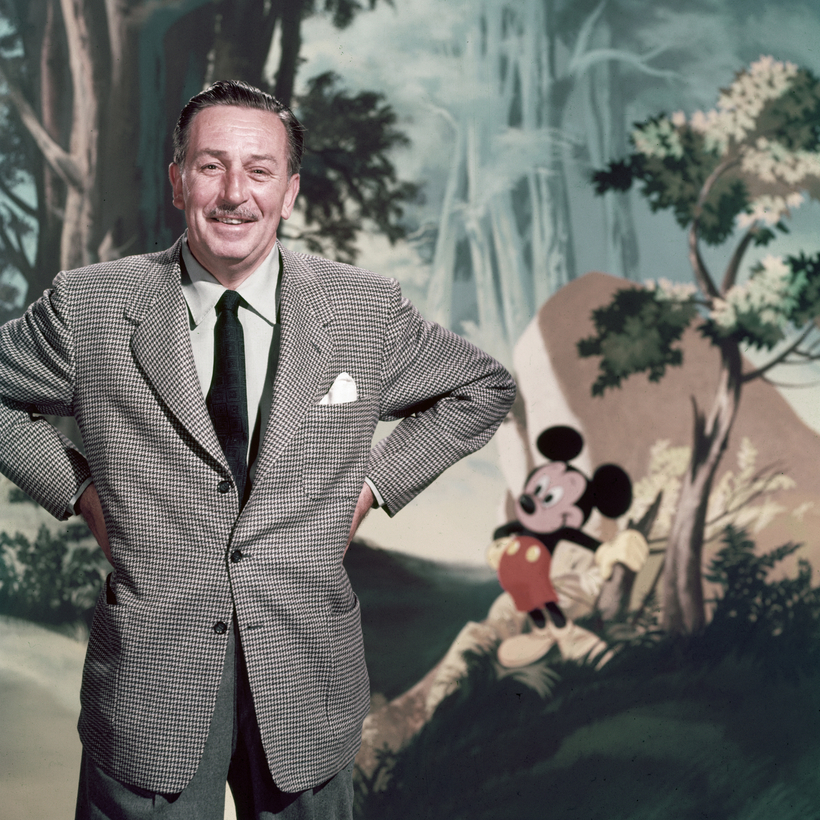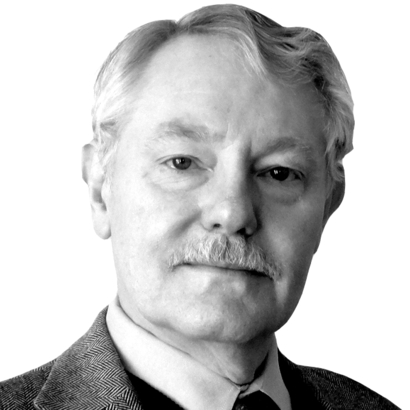On a September Saturday in 1953, Herb Ryman was in his studio working on a painting when the phone rang. He answered it and heard Walt Disney say, “Hi, Herbie. I’m over here at the studio.” On a Saturday? Ryman asked. That made Disney testy. “Yes, it’s my studio and I can be here anytime I want.” Then he changed his tone. “I wonder if you could come over here. Just come the way you are. I’ll be out front waiting for you.” Ryman “was curious and flattered that he picked up the phone and called me. I had no idea what he wanted.”
Herbert Ryman had been set on becoming an artist since he’d been a child in Vernon, Illinois, but he had to nearly die first. “I loved to draw, and everybody looked on it as a harmless hobby.” It didn’t seem so harmless by the time he was in college. His mother was adamantly opposed: Ryman’s father had been a surgeon, killed on the Marne in the First World War, and she was determined that her son honor his memory by becoming a physician, too. But when a severe bout of scarlet fever brought Herbert close to the grave, she relented and, once he’d recovered, sent him to the Chicago Art Institute, where he graduated cum laude.
Every Little Thing He Does
In 1932, Ryman joined the art department at Metro Goldwyn Mayer, and rose to design David Copperfield, A Tale of Two Cities, Mutiny on the Bounty, and The Emerald City of Oz. This last assignment especially reflected his strengths. He was a first-rate illustrator who painted with dash and brilliance; he could create moody evocations of fantastic places: Grimm Brothers forests, future cities, enchanted castles.
In 1938, Walt Disney saw a display of his work at the Chouinard Art Institute in Los Angeles and at once hired him away from M.G.M. Ryman flourished at the Disney Studios, becoming an art director for Dumbo and Fantasia.
He had left Disney in 1946 to go to Twentieth Century Fox. “I had deserted Walt, which was a very criminal act (or at least he thought it was).” So when he got the call, Disney hadn’t been his boss for years, and possibly held a grudge against him. Still, a summons from Walt Disney was not easily flouted. He went at once.
“It’s my studio and I can be here anytime I want,” said Disney.
Disney met him and shook his hand. “Hi, Herbie, we’re in the Zorro Building.” Once there, Ryman asked what was going on. Disney told him, “We’re going to build an amusement park.”
“That’s interesting.” Ryman said. “Where are you going to build it?”
“Well, we were going to do it across the street, but now it’s gotten too big. We’re going to look for a place.”
“What are you going to call it?”
“I’m going to call it Disneyland.”
Disney explained that the project had been germinating in his mind for a long time. Disneyland would be different from any other amusement park ever built. And it would cost plenty, far more than Disney could afford. But he’d had an idea of how to raise the money. The obstreperous new medium of television had alarmed most moviemakers, but Disney saw in it valuable possibilities for advertising, and for raising capital.

That Monday, his brother Roy was going to New York to pitch a Walt Disney television series. He expected a warm reception—there had been a good deal of interest in a Disney TV show—but there was a hook. Any station that signed on for the show would also have to pay for the park.
Disney fully realized that TV executives might not be eager to enter the faded and ramshackle outdoor-amusement industry. Still, the show was bound to be good, and Roy would have with him a powerfully persuasive rendering of an aerial view of the proposed park.
Intrigued, Ryman asked to see the drawing.
“You’re going to do it.”
The artist was appalled. “No. I’m not. You’re not going to call me on Saturday morning at 10 A.M. and expect me to do a masterpiece that Roy could take and get the money. It will embarrass me and it will embarrass you.”
Disney started to plead, his visitor said, “like a little boy who wants something.” With tears in his eyes, “Walt paced back and forth. Then he went over into the corner and he turned his head around with his back to me and said coaxingly, ‘Will you do it if I stay here with you?’”
Ryman gave in. “I knew I couldn’t do a good job, but if he wanted to stay up all Saturday night and all Sunday night, I figured I could do it, too.”
Sight Unseen
Ryman started to draw and Disney started to talk. “This is a magic place. The important thing is the castle [the studio was in the early stages of filming Sleeping Beauty]. Make it tall enough to be seen from all around the Park. It’s got to keep people oriented. And I want a hub at the end of Main Street, where all the other lands will radiate from, like the spokes in a wheel. I’ve been studying the way people go to museums and other entertainment places. Everybody’s got tired feet. I don’t want that to happen in this place. I want a place for people to sit down and where old folks can say, ‘You kids run on. I’ll meet you there in a half hour.’ Disneyland is going to be a place where you can’t get lost or tired unless you want to.”

Ryman sketched a rough triangle on a big sheet of tissue—43 by 70 inches—and started to fill it in with hills and rivers; he put Mississippi stern-wheelers and an ancient square-rigger on the waterways, added a castle with a carousel in the courtyard, and, running from the park’s single entrance to the castle, a broad street lined with late-Victorian buildings. He blocked out various “lands” with their potential names: Frontier Country, Holiday Land, Mickey Mouse Club, Fantasy Land, Lilliputian Land, World of Tomorrow, True-Life Adventure Land.
“This is a magic place. The important thing is the castle. Make it tall enough to be seen from all around the Park.”
Fueled by milkshakes and tuna-fish sandwiches, the two worked through the weekend in the blue haze of Disney’s Chesterfields. Ryman could do bold cityscapes with an almost expressionist palette, but this drawing was crisp and literal, delicate and full of appealing specifics. Forty hours after Disney’s phone call, Ryman set down his carbon pencil. The two men looked at the finished work.
What they had conjured from Disney’s vision and Ryman’s patient skill was remarkably close to what, two years and many millions of dollars later, would rise from the vanished orange groves of Anaheim, California, to tease the imagination of the entire world.
Frontier stockade and space port, jungle river and carousel were marshaled together within a steel border demarcated by the salient instruction Disney had given his artist at the outset: “Herbie, I just want it to look like nothing else in the world. And it should be surrounded by a train.”


